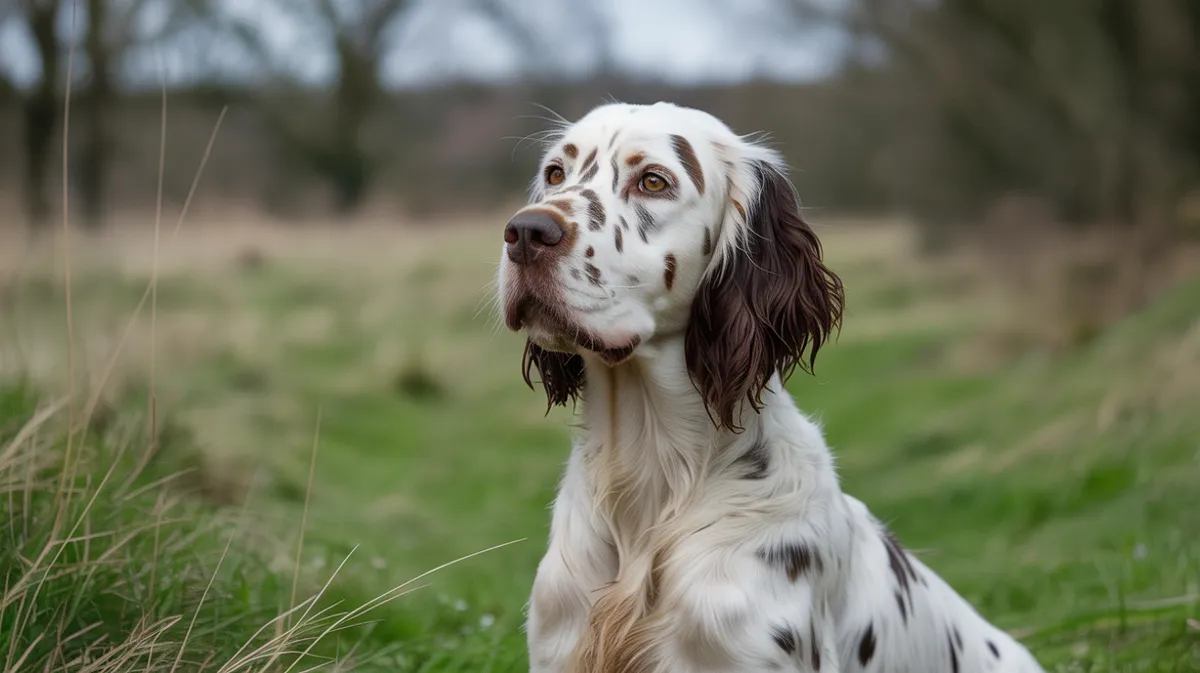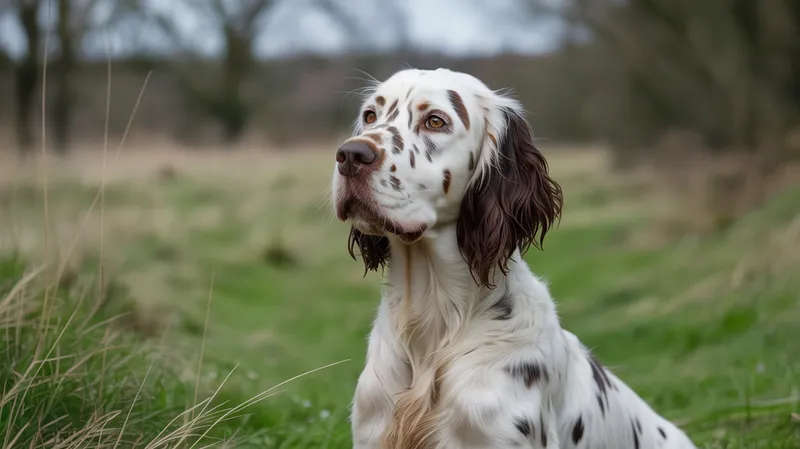
English Setter
Canis lupus familiaris

Meet the English Setter
The English Setter is a medium to large breed of gundog known for its elegant appearance and friendly temperament. Renowned for its feathered coat, distinctive speckled markings, and graceful movement, this breed was originally developed in England as a bird dog, specifically for setting and pointing game birds. English Setters are highly trainable, gentle, and affectionate, making them both excellent family companions and skilled working dogs in the field. They require regular exercise and mental stimulation due to their energetic and intelligent nature.
Classification
Mammal
Habitat
Rural, grassland, and forested areas; commonly found in country homes and sporting estates
Diet
Omnivore
Lifespan
10-12 years
Conservation
Least Concern
Weight
20-36 kg (44-79 lbs)
📖Fascinating Facts
Distinctive Coat Pattern
The English Setter's coat features a unique 'belton' pattern, which consists of white fur flecked with colored specks, most commonly blue (black), orange, lemon, liver, or tricolor.
Skilled Bird Dog
Historically bred as a gundog, English Setters are celebrated for their ability to locate and 'set' or point at upland game birds, making them valuable assets for hunters.
Family-Friendly Nature
English Setters are gentle, affectionate, and sociable, often thriving in family environments and getting along well with children and other pets.
📋Detailed Description
The English Setter is a medium to large, athletic dog breed, typically standing 61–68 cm (24–27 in) at the shoulder and weighing 20–36 kg (44–79 lbs), with males generally larger than females. It is distinguished by a long, lean head, a deep chest, and a level topline, giving it a graceful, flowing silhouette. The breed's hallmark is its silky, flat, feathered coat, predominantly white with distinctive flecked markings known as 'belton' in blue (black), orange, lemon, liver, or tricolor combinations. English Setters possess a long, tapering tail carried level with the back, and their ears are low-set, hanging close to the head. Anatomically, they have a well-developed nose and large nostrils, adaptations for scent detection. Their eyes are oval and expressive, reflecting their gentle temperament. Behaviorally, English Setters are known for their stamina and endurance in the field, as well as their affectionate, sociable nature at home. They are highly trainable, intelligent, and sensitive, responding best to positive reinforcement. Their gundog heritage is evident in their unique 'setting' behavior—crouching low to indicate the presence of game birds. English Setters are generally healthy, with a lifespan of 10–12 years, though some lines may be prone to hereditary health issues such as hip dysplasia and deafness.
💡 Did you know?
Despite being energetic outdoors, English Setters are known to be calm and relaxed inside the home, often earning the nickname 'couch potato.'
🔬Research & Sources
Wikipedia Summary
The English Setter is a medium-size breed of dog. It is part of the setter group, which includes the red Irish Setters, Irish Red and White Setters, and black-and-tan Gordon Setters. The mainly white coat has long silky fringes on the back of the legs, under the belly and on the tail. The coat features flecks of colour, and the different colour varieties are referred to as 'belton'.
Last Modified: 2/19/2025
🎭Behavior & Social Structure
English Setters are energetic and require significant daily exercise, thriving on activities such as running, hiking, and especially fieldwork. In hunting contexts, they exhibit a distinctive quartering pattern, systematically sweeping the ground in search of scent, then freezing in a low crouch or 'set' when game is detected. Their olfactory acuity is exceptional, and they are capable of working over large areas for extended periods. Socially, they are highly people-oriented, forming strong bonds with family members and generally getting along well with children and other dogs. They are not typically aggressive but may be reserved with strangers. English Setters are known for their playful, gentle demeanor and can be prone to separation anxiety if left alone for long periods. Their daily routines should include both physical exercise and mental stimulation, such as scent games or advanced obedience work, to prevent boredom-related behaviors.
👶Reproduction & Life Cycle
English Setters are monoestrous, with females typically coming into heat twice a year. The breed does not have a defined breeding season, although most litters are planned in spring or autumn for optimal conditions. Mating is usually supervised by breeders to ensure genetic health and temperament. Gestation lasts approximately 63 days. Litter sizes range from 6 to 10 puppies, though larger litters are not uncommon. Both parents may display nurturing behaviors, but the dam provides the majority of care, including nursing and grooming. Puppies are born blind and deaf, opening their eyes at around 10–14 days. Breeders often begin early socialization and basic training at 3–4 weeks to encourage stable temperaments. Responsible breeding practices include screening for hereditary conditions such as hip dysplasia, elbow dysplasia, and congenital deafness.
🛡️Adaptations & Survival
Physically, English Setters have evolved a light, athletic build and strong hindquarters for stamina and speed, enabling them to cover rough terrain efficiently. Their long, silky coat provides protection against brush and inclement weather, while feathering on the legs and tail helps to shield sensitive areas. The breed's acute sense of smell and large, open nostrils are specialized for detecting faint avian scents. Behaviorally, their instinctive 'setting' posture is an adaptation for hunting, minimizing disturbance to game birds while alerting the handler. Their gentle, biddable temperament is a result of selective breeding for cooperative work with humans. High intelligence and trainability further enhance their suitability as both working dogs and companions.
📚Research Sources
🎨Cultural Significance
The English Setter has played a prominent role in British sporting culture since the 16th century, prized by nobility and gamekeepers for its skill in locating and indicating upland game birds. The breed is closely associated with the development of modern field trial competitions and has influenced the evolution of other setter breeds. Notable strains include the Laverack, Llewellin, and Ryman types, each with distinct field or show characteristics. English Setters have appeared in literature, art, and even on postage stamps, symbolizing elegance, loyalty, and sporting tradition. Their gentle nature has made them popular family pets, and they are often featured in dog shows and canine sports worldwide.
🔬Recent Research & Discoveries
Recent genetic studies have focused on identifying markers for hereditary deafness and hip dysplasia in English Setters, contributing to improved screening protocols. Ongoing research by veterinary geneticists aims to map the breed's genome to better understand inherited diseases and inform breeding decisions. Behavioral research has examined the setter's olfactory capabilities and working memory, confirming their exceptional scenting ability and trainability. Conservation genetics studies have highlighted the importance of maintaining genetic diversity, particularly in working lines. The breed has also been included in studies on canine cognition and social behavior, given its high sociability and responsiveness to human cues.
🎥Wildlife Videos

Dogs who must wander: The American Setter
Watch this documentary about a rarity of our world... the American Setter.
Fun Collective studio -

Champion Bird Dogs Pointers, Setters & Spaniels 1940 Pictorial Films; Hunting Dogs, Retrievers
1940 Pictorial Films.
Military History TV

Brothers in hunt - ptarmigan hunting in Lapland with four English Setter gun dogs retrieving.
A trip to Lapland is an adventure of a lifetime for two old friends and four hunting dogs. In this short film, a fulfilling, dream week of ...
Altitude and Trails

English Setters hunting challenging woodcock in Sicily - HuntMag
Hunting trip to Sicily, pursuing the queen of the woods, HuntMag journalist Lucas Micallef was guest of Antonino Urpi who owns ...
HuntMag.eu

Woodcock Hunting with Gordon Setters - Project Upland Magazine with Stephen Faust
Stephen Faust has grown up following hunting dogs in the pursuit of wild birds. This story takes us on his journey as a breeder of ...
Project Upland Magazine

A Ryman Setter Story - Walt Lesser - Bird Hunting the Canaan Valley of West Virginia
The Ryman Setter is one of the most celebrated bloodlines of the English Setter breed. Starting with George Ryman it was passed ...
Project Upland Magazine
🌍Habitat Information
The English Setter typically inhabits Rural, grassland, and forested areas; commonly found in country homes and sporting estates environments. English Setters have adapted to their environments with specialized features and behaviors.
Primary Habitat:
Rural, grassland, and forested areas; commonly found in country homes and sporting estates
More detailed habitat information will be available soon.
🛡️Conservation Status
The English Setter is currently classified as Least Concern. Conservation efforts are crucial for preserving this species for future generations.
Common Threats:
- 🏠Habitat loss and fragmentation
- 🌡️Climate change impacts
- 🎯Hunting and poaching
- 🏭Human-wildlife conflict
⚠️Threats & Conservation Challenges
While the English Setter is not considered at risk globally, several challenges affect the breed. These include a shrinking gene pool due to selective breeding for show or field traits, which can increase the prevalence of hereditary diseases. Common health concerns include hip and elbow dysplasia, congenital deafness (especially in predominantly white dogs), hypothyroidism, and progressive retinal atrophy. In some regions, declining interest in traditional gundog work and changes in land use have reduced the demand for working setters, impacting population trends. Responsible breeding, health screening, and breed stewardship are essential to maintaining genetic diversity and overall breed health.
🔬Scientific Classification
Scientific Name
Canis lupus familiaris
Classification Hierarchy
🔍 About Taxonomic Classification
Taxonomic classification is a hierarchical system used by scientists to classify and organize living organisms based on shared characteristics and evolutionary relationships.
The system moves from broad categories (Kingdom) to increasingly specific ones, with each animal's scientific name typically consisting of its Genus and species.
📝Community Notes
Share your observations and insights about the English Setter with our community of wildlife enthusiasts.
Join Our Community
Sign in to share your observations and connect with fellow wildlife enthusiasts.
Sign In to ContributeNo community notes yet
Be the first to share your observations about the English Setter!
Explore English Setter
Select a tab above to learn more about this amazing animal.
📸Photo Gallery
No photos available for this animal yet.
🌟Discover More Wildlife
Continue your journey of discovery with more fascinating animals from our database
